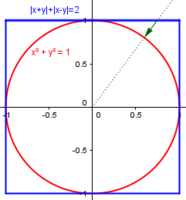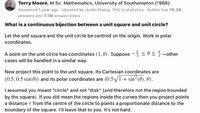Cratylus
Junior Member
- Joined
- Aug 14, 2020
- Messages
- 82
Prove that a unit circle centred at the origin is homeomorphic to a square with a unit perimeter centred at the origin
l have researched it and looking at answers,it gives me headaches
So let C:={[MATH]x^{2}+y^{2}=[/MATH] 1 }. S={(0,1) x (0,1) }
Show C~S
l was thinking first to show each vertex of the square is homeomorphic to (0,0) on the circle
Then I found this: https://math.stackexchange.com/q/2765821/919044
(2) and (3) l can handle,Not sure about (1)
Any help would be greatly appreciated Dealing with the geometry gives me the heebie geebies.
l have researched it and looking at answers,it gives me headaches
So let C:={[MATH]x^{2}+y^{2}=[/MATH] 1 }. S={(0,1) x (0,1) }
Show C~S
l was thinking first to show each vertex of the square is homeomorphic to (0,0) on the circle
Then I found this: https://math.stackexchange.com/q/2765821/919044
(2) and (3) l can handle,Not sure about (1)
Any help would be greatly appreciated Dealing with the geometry gives me the heebie geebies.


